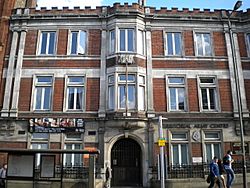St John's Hill Drill Hall facts for kids
Quick facts for kids St John's Hill Drill Hall |
|
|---|---|
| Lavender Hill, London | |

St John's Hill Drill Hall
|
|
|
Location within London
|
|
| Coordinates | 51°27′47″N 0°10′11″W / 51.46305°N 0.16975°W |
| Type | Drill hall |
| Site history | |
| Built | 1882 |
| Built for | War Office |
| In use | 1882-Present |
St John's Hill Drill Hall is a military building in London. It is located on Lavender Hill. A drill hall is a place where soldiers train and practice. Since 1993, this building has been the main office for the London Regiment.
Contents
History of the Drill Hall
Early Days and New Buildings
The story of St John's Hill Drill Hall began in 1882. A group of volunteer soldiers, part of the East Surrey Regiment, took over a property. It was called Gothic Villa and was on St John's Hill. These volunteers later became the 4th Volunteer Battalion of the East Surrey Regiment in 1887.
In 1897, a person named Lord Wandsworth helped buy the land completely. Around that time, a drill hall was built at the back of the property. It was designed by B. T. L. Thomson. In 1902, a new three-story building was added to the front. This part looked like a small castle and was designed by H. Wakeford & Sons.
World War I and Changes
The volunteer group changed its name again in 1908. It became the 23rd (County of London) Battalion, London Regiment. When World War I started in August 1914, these soldiers were called to action at the drill hall. They were then sent to fight on the Western Front in Europe.
After the London Regiment was reorganized in 1937, the unit at the drill hall became the 42nd Royal Tank Regiment. This meant they now used tanks.
Post-War and Modern Use
After World War II, the unit at the drill hall changed names several times. In 1956, it became the 23rd London Regiment, the East Surrey Regiment. Then, in 1961, it changed to the 4th Battalion the Queen's Royal Surrey Regiment.
The drill hall continued to be an important military base. In 1988, it became the main office for the 8th (Volunteer) Battalion. This group was called the Queen's Fusiliers (City of London). Finally, in 1993, it became the official headquarters for the London Regiment. It still serves this purpose today.


